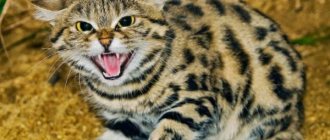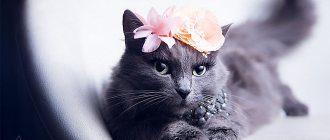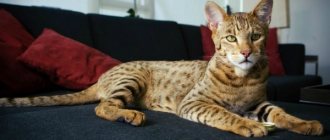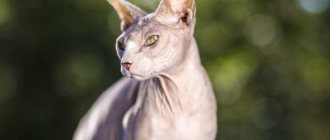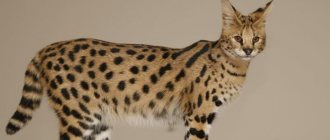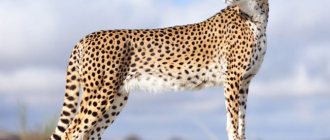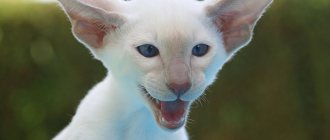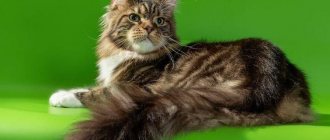The Internet is filled with all sorts of lists of the most evil animals, and cats are no exception. However, most of these classifications have a very indirect relationship to reality, since it is incorrect to talk about a breed as a guarantor of a certain set of character traits of an animal. In addition, anger in cats and anger in humans are completely different concepts that cannot be equated. Wild cats that do not allow humans to approach can be called evil, or domestic cats that are spoiled by their owner can be called evil. Let's talk further about who the most evil cats are and what is the reason for cat aggression.
The most evil cats
Ural Rex
This breed first gained popularity in pre-war times. But after the war, the number of these cats decreased, and for a long time they were considered to have disappeared forever.
But in the 60s, it became known about Ural Rex breeders, and the myth about the disappearance of the breed was dispelled, although the breed is still considered quite rare.
People who buy a handsome Ural cat most often think about its unusual appearance, but do not think at all about the unpredictable nature of this cat.
Most often, such cats behave quite friendly and affectionately, but at any moment the cat’s behavior can change in a sharply negative direction. So owners and their guests should beware of sudden bites from their pet.
Siamese cat
Siamese cats are considered one of the most beautiful in the world. This breed is very popular not only because of its beautiful appearance, but also because of its high intelligence.
These cats are very smart and easy to train. They are easy to train and even loyal to humans. But in addition to high intelligence, these cats also received phenomenal memory.
Once the owner offends a Siamese cat at least once, he will remember it forever. And not only will he remember, but he will also want to take revenge at the moment when the enemy is unarmed.
There are many examples of Siamese cats attacking their owners while the latter were sleeping in bed. Therefore, you should not offend Siamese cats or treat them unfairly.
Features of aggression
8 eternal kittens: the smallest cat breeds
It is easy to recognize the appearance of aggression in a cat of any breed. Characteristic signs include nervous tail wagging, ears pinned back to the head, dilated pupils and hissing.
The cat is hunting
You should also be wary of the fact that she is trying to hide or presses herself to the floor to attack her owner. For some time it is better not to approach her and not get into her field of vision. If such a problem arises, then you should not treat it negligently. As a result of this behavior, sleep disturbances, decreased immunity may occur, and ultimately, the cat will become very irritable and will not be able to control its aggression.
Manul
Manul is one of those breeds that cannot be tamed. These cats are too freedom-loving and will never obey a person.
It is worth noting that the disobedience of the Pallas cat is primarily due to the fact that he is not a domestic cat, but a wild one. That is, these cats feel very comfortable living in natural conditions, but they are not adapted to living side by side with humans.
As soon as the manul senses danger, he will immediately attack the person. Its claws are considered very powerful by feline standards, and its fangs are 3 times longer than those of an ordinary cat. It is worth noting that Pallas cats not only behave aggressively, but also look quite menacing.
Maine Coon
Representatives of this breed delight people with their stern appearance and massive body. In size, they are almost twice the size of ordinary cats.
They are distinguished not only by their beautiful and unusual appearance, but also by their flexible mind and high intelligence.
Maine Coons by their nature are real phlegmatic people. They are quite calm and confident. However, if you raise a Maine Coon incorrectly, you can end up with frequent hissing and attempts by the cat to bite or scratch not only strangers, but also its own owner.
However, you should not think that aggressive individuals are common among Maine Coons. Rather, the aggression of this breed is the result of improper upbringing or lack of proper attention of the owner to the cat person.
Savannah
On the pedestal of the most evil cats, the first place belongs to the Savannah, the most aggressive with the genes and blood of wild African servals. Although breeders believe that their work has resulted in a balanced and sweet animal. Savannah especially does not tolerate strangers if it goes for a walk on a leash with its owner - it may well attack a passerby if it considers him dangerous.
Breeders often keep Savannahs in enclosures, since they are quite large cats; if the animal shows aggression, it is removed from breeding. Strangers and pats on the back are two factors that can lead to an angry state, accompanied by hissing and the desire to scratch and bite. Be careful with the savannah!
In the end, we note that, as with affectionate breeds, so with angry ones, the character is determined by upbringing, affection, and care. If, after all, the animal is aggressive, then think about the reason for this behavior. Maybe a stressful situation? Or contact-coercion on the part of the owner? Be patient, attentive and allow the animal to trust you.
Top 10 most evil cats - Which purebred cats are the most aggressive? Review + Photos and Videos
Most people think of cats as fluffy, purring, and the cutest animals. Until someone's razor-sharp claws grab their hand.
Or biting teeth. Or the first and second at the same time.
Now we’ll tell you which cat breeds are the most evil.
The leading and at the same time permanent place in the ranking of the Top 10 evil cat breeds belongs to Siamese cats, terrible jealous cats and hunters.
You wouldn’t guess from the angelic blue eyes and beautiful coloring that the owner of cute features is vengeful, holds a grudge for a long time and is capable of inflicting reprisals on the offender at the most inopportune moment.
Cathesian
Not the most common, but one that ranks among the top evil cat breeds is the Chartreuse or Cathesian. Cats of French origin are extremely jealous, considering themselves the only ones they love. They cannot stand competition, they do not want strangers and are afraid of them, and for this reason they do not get along with other pets at all. Their capricious nature also requires space for maintenance; a private house is perfect.
Self-sufficiency, impatience with changes in daily routine and habitat, and reluctance to forced hugs make Chartreux not the most desirable family members. But if they really love the owner, they will show him their affection in every possible way and seek attention.
Bengal cat
It is no secret that Bengal cats were bred by crossing domestic cats and wild ones. Therefore, in the character of this breed, the temperament of a gentle domestic cat and the burrows of a real wild, unbridled predator are intricately crossed with each other.
In normal circumstances, Bengals are quite calm and serene animals, whose behavior is no different from other domestic cats. However, if it seems to them that there is danger somewhere nearby, the hunting instinct takes over. Therefore, Bengal cats can seriously harm humans.
It is also worth noting that this breed is practically not trainable.
Bengal
Another representative of the evil cat family is the Bengal, with a pronounced hunting instinct and incredibly impressive appearance. Many of the representatives of the Bengal breed have impulsive character traits, due to which the animal becomes aggressive, capable of even attacking the owner in case of contradictions.
Raising your voice, much less shouting, is not tolerated. Day after day, Bengals tirelessly drive everywhere, and this continues until old age. Not everyone will like this. If the owner does not want to get a pet that will constantly attack him, he needs maximum attention, affection and care for the representatives of the breed.
Chausie
The chausie is also not of the kindest disposition; it is wild and capricious, slightly reminiscent of a puma in appearance. The chausie is distinguished by its size and highly developed hunting instinct. There is no place for them in a small apartment because of their large dimensions and desire to run around, their love of occupying mezzanine and above closet spaces, creating reserves and secret storage areas, which the owners will periodically access.
jungle cat
Jungle cats are still considered wild, despite the fact that more and more people are expressing a desire to have a representative of this breed at home.
People are most often captivated by the resemblance of this unusual cat to a lynx. The charming tufts on the ears and the massive size of the jungle cat certainly look beautiful.
But nevertheless, the natural predatory habits of the breed make themselves felt, and experts generally advise against keeping a jungle cat at home because of its evil and unpredictable nature.
Attention! People who have small children living in the house should especially beware of purchasing this breed. Taming a jungle cat is no easier than taming a lynx or a cheetah
